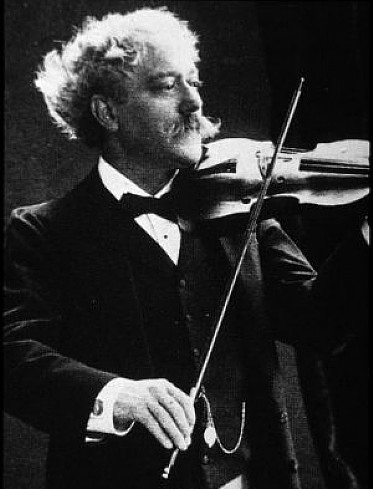Hergova Violins, old French Violins & bows
The violin has attracted some of classical music's most virtuosic and flamboyant soloists over the last 500 years. There are literally hundreds who could be described as truly great violinists so it's not easy picking out a particular group as being the very best. However, what one can say, is that they have all brought a great love and feeling for music to this wonderful, unique instrument that can frustrate, tease, torment, cajole and mesmerise all at the same time! We suggest you look here for a wonderful version of Max Bruch's Violin Concerto in G minor.
We want to highlight some of those players from the past and remember why, in their heyday, they were regarded as being particularly special and how, although musical tastes change, the instrument they played so well has remained pretty much the same over its' long history. It continues to dazzle and intoxicate modern audiences as much as it did 100, 200 or even 500 years ago.
Violinist of the month Pablo Sarasate, late 18th / early 19th century
 Pablo Sarasate was born in Pamplona, Navarre, the son of an artillery bandmaster. He began studying the violin with his father at the age of five and later took lessons from a local teacher. His musical talent became evident early on and he appeared in his first public concert in A Coruña at the age of eight.
Pablo Sarasate was born in Pamplona, Navarre, the son of an artillery bandmaster. He began studying the violin with his father at the age of five and later took lessons from a local teacher. His musical talent became evident early on and he appeared in his first public concert in A Coruña at the age of eight.
His playing attracted the attention of a wealthy patron who provided funding for Sarasate to study under Manuel Rodríguez Saez in Madrid where he became a farourite of Queen Isabel II.
Sarasate, who had played in public since childhood, made his debut Paris as a concert violinist in 1860 playing in London the next year , During his career, he toured many parts of the world, performing in Europe, North America, and South America. His artistic excellence is due primarily to the purity of the tone he produced and technical excellence.
His artistic pre-eminence was due principally to the purity of his tone, which was free from any tendency towards the sentimental or rhapsodic, and to that impressive facility of execution that made him a virtuoso. In his early career, Sarasate performed mainly opera fantasies, most notably the Carmen Fantasy, and various other pieces that he had composed. The popularity of Sarasate's Spanish flavour in his compositions is reflected in the work of his contemporaries. Perhaps the best known of his works is Zigeunerweisen (1878), a work for violin and orchestra. Another piece, the Carmen Fantasy (1883), also for violin and orchestra, makes use of themes from Georges Bizet's opera Carmen. Probably his most performed encores are his two books of Spanish dances, brief pieces designed to please the listener's ear and show off the performer's talent. He also made arrangements of a number of other composers' work for violin, and composed sets of variations on "potpourris" drawn from operas familiar to his audiences, such as his Fantasia on La forza del destino (his Opus 1), his "Souvenirs of Faust", or his variations on themes from Die Zauberflöte. In 1904 he made a small number of recordings. In all his travels Sarasate returned to Pamplona each year for the San Fermín festival.
Sarasate died in Biarritz, France, on 20 September 1908, from chronic bronchitis. He bequeathed his violin, made by Antonio Stradivari in 1724, to the Musée de la Musique. The violin now bears his name as the Sarasate Stradivarius in his memory. His second Stradivari violin, the Boissier of 1713, is now owned by Real Conservatorio Superior de Música, Madrid. Among his violin pupils was Alfred De Sève. The Pablo Sarasate International Violin Competition is held in Pamplona.
The video clip is of Gil Shaham playing Zigeunerweisen in Japan.Further information about Pablo de Sarasate can be found on the Pabo de Sarasate widepedia page.
